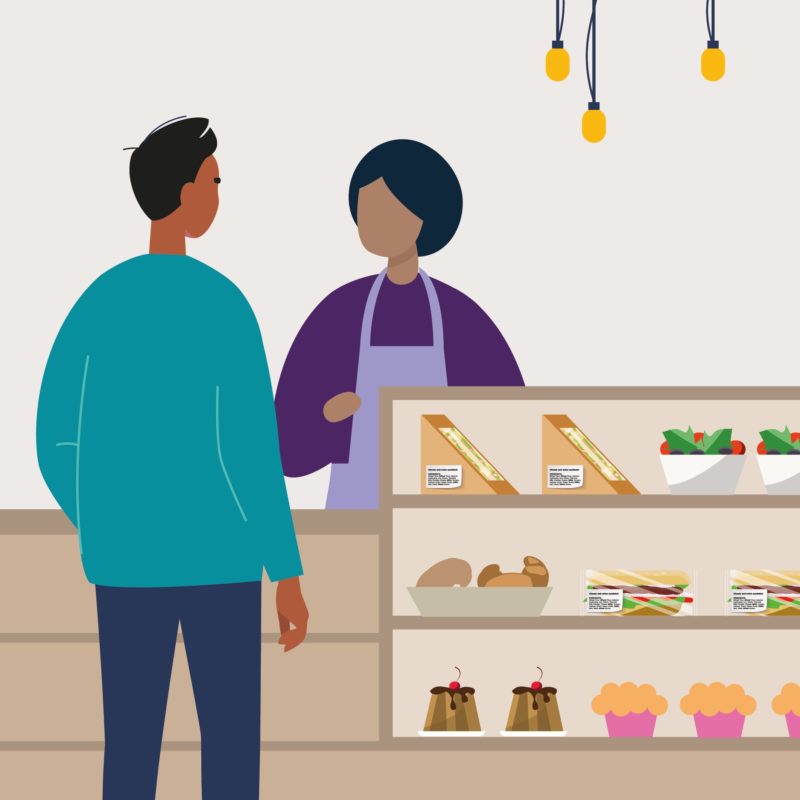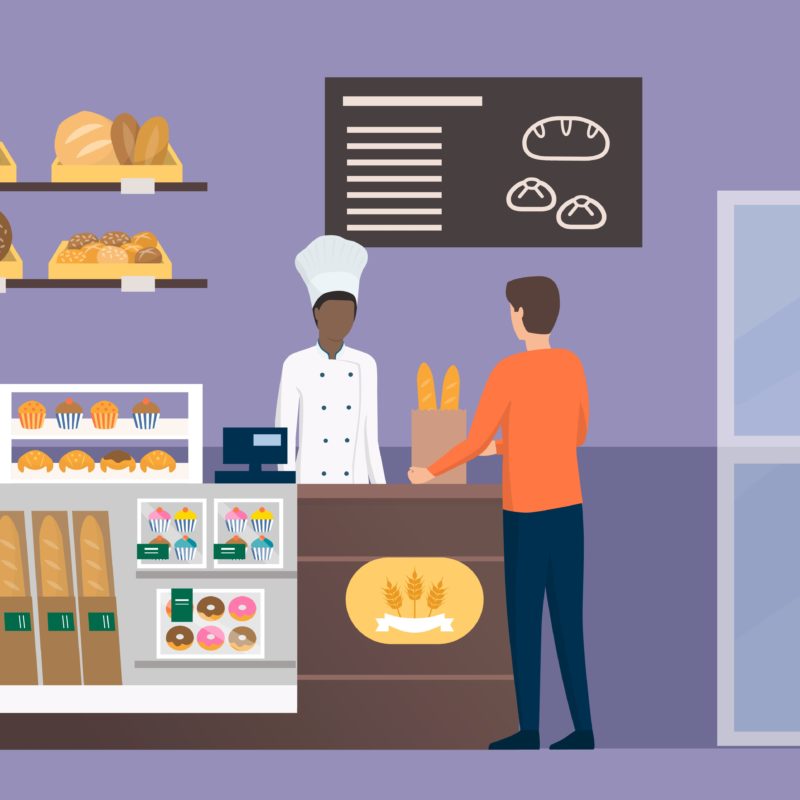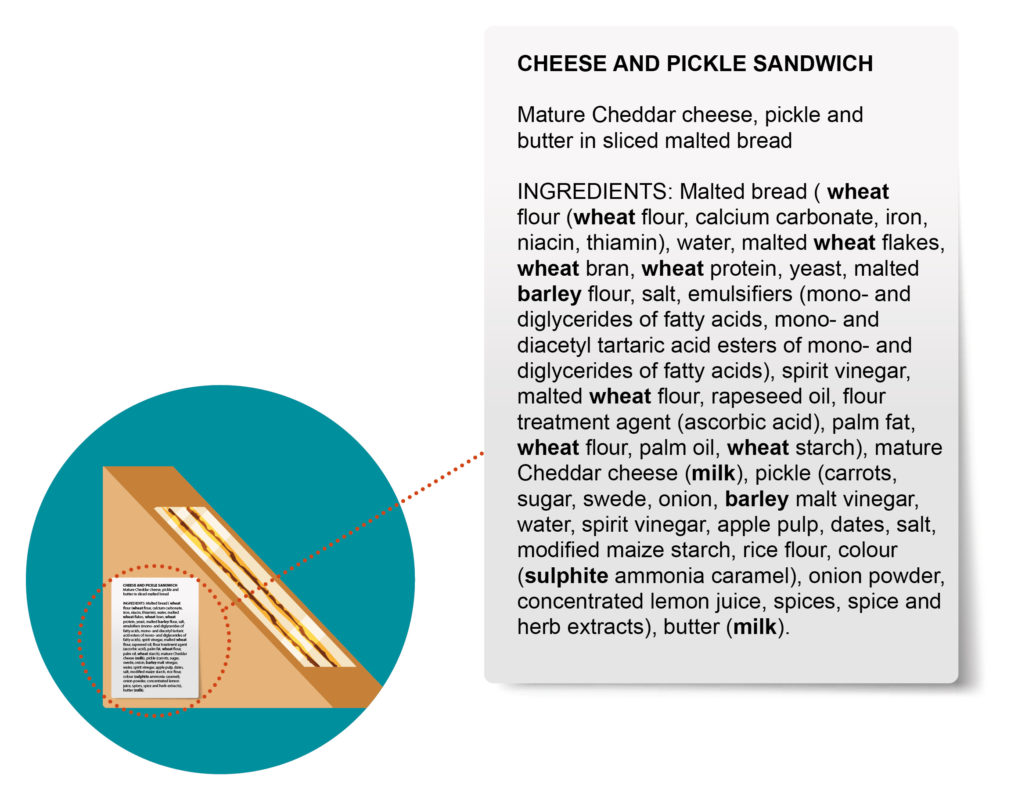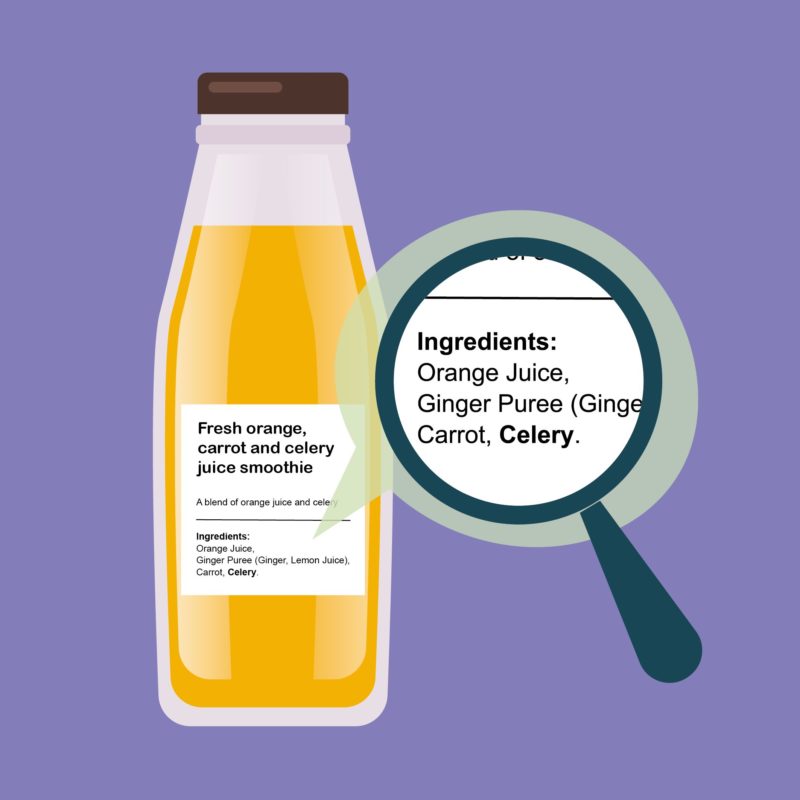Digital Food Safety System
Save time, reduce hassle and keep your business inspection-ready.

Natasha’s law was introduced in October 2021 as an amendment to the Food Information Regulations.
Since then there has been a requirement for food and drink which is prepacked for direct sale (PPDS) to be labelled with:
Prepacked for direct sale or PPDS is food or drink which is packaged at the same place it is offered or sold to consumers and is in this packaging before it is ordered or selected.
It can include food that consumers select themselves (e.g. from a display unit), as well as products kept behind a counter and some food sold at mobile or temporary outlets.
For example:
*guides for different types of businesses including one for mobile businesses that we developed with the FSA can be found further down this page


Any food that is not in packaging or is packaged after being ordered by the consumer. These are types of non-prepacked food and do not require a label with name, ingredients and allergens emphasised. Allergen information must still be provided but this can be done through other means, including orally. For example a takeaway meal that is ordered over the phone – that is prepared and packaged after the customer has placed their order and discussed any specific requests. This is classed as Distance selling – food purchased over the phone or internet.
Food packed by one business and supplied to another business. This is prepacked food and already must have full labelling, including the name of the food and a full ingredients list, with allergenic ingredients emphasised within it.
Distance Selling
If selling food over the phone or internet then allergen information must be available to the customer:
and
Food is PPDS if:
Examples of this kind of packaging would be:
Food is not PPDS if it does not have packaging, or if it is packaged in a way that the food can be altered without opening or changing the packaging (for example a burger served on an open cardboard tray).
The food labels need to be in line with the legal requirements that apply to naming the food and listing ingredients. For more information, click here.
You must still ensure they comply with existing relevant food information and labelling requirements for the country you operate in.
The FSA have updated their allergen guidance for food businesses to include the new requirements. More information is available here.


The NCASS ‘is it PPDS?’ checker tool
This will help you find out whether what you are selling PPDS food or not.
Allergy Awareness Training
The course is up to date with all current allergen legislation and can be completed online!
Below is a list of questions we were asked during our webinar with the FSA, you will find questions from members below and the answers to their questions from the FSA.
The FSA’s Technical Guidance on Food allergen labelling and information requirements was revised in June 2020 with information on PPDS. You can find it here: https://www.food.gov.uk/sites/default/files/media/document/fsa-food-allergen-labelling-and-information-requirements-technical-guidance_0.pdf
More information on PPDS is available on our website at: https://www.food.gov.uk/business-guidance/introduction-to-allergen-labelling-changes-ppds
Our online e-training on food allergy and intolerance also contains information on PPDS. You can access the training here: https://allergytraining.food.gov.uk/
The training is particularly relevant to food businesses and local authorities.
All food products sold through distance selling (such as over the internet or by telephone) already require allergen information to be available before food is ordered and when it is delivered. This will not be affected by the new regulations.
But if you ordered a packet of prawn crackers in person at the business, and it was packaged before you chose it, the packet would be PPDS and would need to be labelled.
Any food business could be affected, including street food.
PPDS is food that is packed before being offered for sale by the same food business to the final consumer:
So, if you are a street food vendor and you pack your own food product before it is ordered by a consumer you are affected by the PPDS rules.
You can use our online tool to see if you produce PPDS food: https://www.food.gov.uk/allergen-ingredients-food-labelling-decision-tool
If the food is prepacked before it has been ordered by the customer and sold from the same site it was packed, a label with a full ingredient list is required with allergens emphasised within the text. You can continue to advise customers orally, in addition to the requirements for PPDS labelling.
If you produce ‘non-prepacked’ food (that is loose before a customer orders it) you can continue to advise customers as you do now, providing allergen information orally or in writing.
Any food business could be affected, so each business will need to check if they produce foods that fall under the PPDS definition.
If a business packs a product on the same site as which it is sold, and it is in packaging before customer orders it, in person, this is PPDS food and should be labelled.
All food products sold through distance selling (such as over the internet or by telephone) already require allergen information to be available before food is ordered and when it is delivered. This will not be affected by the new PPDS regulations.
If the food is prepacked before it has been ordered by the customer and sold from the same site as it was packed (or is packed by the same business at different locations if you are a mobile business), a full ingredient list is required with allergens emphasised within the text.
If the food is made or packed to order, this is non-prepacked food. Allergen information for non-prepacked food can be communicated through a variety of means to suit the format of the food business. You are required to provide information about the use of the 14 allergens if they are present in a food. You are not required to provide a full ingredients list.
All food products sold through distance selling (such as over the internet or by telephone) already require allergen information to be available before food is ordered and when it is delivered. Food sold in this way does not require the new PPDS labelling and current rules on allergen information continue to apply.
You would need to list all ingredients for the sandwich, including the bread ingredients. So ‘bread’ should be used in a list of ingredients for a sandwich, for example, with a list of the ingredients in the bread following the term ‘bread’.
The list of ingredients should be headed with the word ‘ingredients’. You should include all the ingredients of the food, in descending order of weight.
You can find more information on this in relevant legislation on labelling at: Annex VII, Part E (1) of the retained EU 1169/2011
We’re assuming that any hot drinks you make, are made to order so will not come under the new PPDS rules as they will be ‘non-prepacked’. Allergen information for non-prepacked food can be communicated through a variety of means to suit the format of the food business. You are required to provide information about the use of the 14 allergens if they are present in a food. You are not required to provide a full ingredients list.
But if you are ‘packing’ hot drinks before a customer orders it, then this would come under the new PPDS rules.
Loose items, such as cakes, can be displayed without covering.
If the food is prepacked before it has been ordered by the customer and sold from the same site it was packed, a full ingredient list is required with allergens emphasised within the text.
But any food that is only packed once ordered by the customer is non-prepacked food. You can choose how to provide information on the 14 allergens e.g. orally or in writing.
Food businesses supplying food and food ingredients, from operator to operator, have a duty to pass accurate food information down the supply chain. Suppliers should ensure other food business they supply to operators are provided with sufficient information to enable them, where appropriate, to meet their obligations (as laid out in Article 8(8) of retained EU 1169/2011).
We’re assuming that any hot drinks you make, are made to order so will not come under the new PPDS rules as they will be ‘non-prepacked’. Allergen information for non-prepacked food can be communicated through a variety of means to suit the format of the food business. You are required to provide information about the use of the 14 allergens if they are present in a food. You are not required to provide a full ingredients list. So you should continue to provide the allergen information as you do now.
But if you are ‘packing’ hot drinks before a customer orders it, then this would come under the new PPDS rules.
If a lead booker chooses products on behalf of attendees, then this is classed as food made to order and will not need PPDS labels. You should still make allergen information available to the attendees.
However, if you agree to provide a range of food, but the booker does not make specific choices, then you could consider that the choice of food does not happen until the individual consumer selects it – this would need a label.
You can contact your local authority to talk through the specifics of how you operate and what rules apply to you.
Any information provided by your ingredient suppliers on the potential unintentional presence of allergens should be passed on to your customers. So, you should pass on any ‘precautionary allergen information’ such as ‘may contain…’ or ‘not suitable for…’.
The FSA recommends that information on the unintended presence of allergens for PPDS foods is communicated on the packaging or label to ensure that the allergic consumer is aware of the risk. But you can also provide this ‘precautionary information’ in another form such as on a sign or orally by staff.
This type of information should only be provided if a real risk of allergen cross-contact has been identified following a thorough risk assessment that cannot be removed through risk management actions, for example segregation and cleaning.
If the food is prepacked by you before it has been ordered by the customer and is sold from the same site it was packed, a full ingredient list is required with allergens emphasised within the text. This also applies to food offered for sale from a moveable and/or temporary premises (such as marquees, market stalls, mobile sales vehicles) if the food is offered for sale by the same food business who packed it.
I would assume that your service users are identified well in advance of the food being prepared and packed, and that they specify what they would like beforehand. This would be equivalent of placing an order, which would therefore not be packed before it is ordered. This means this is not prepacked nor prepacked for direct sale (PPDS). This would be non-prepacked food that is sold via distance means. For this allergen information must be made available before the food is ordered and at the moment of delivery. You can contact your local authority to talk through the specifics of how you operate and what rules apply to you.
The same product can fall under different allergen information rules depending on the context. So yes, if you package a brownie following a customer’s order you do not need a PPDS label (but you should still be able to provide allergen information in a manner of your choosing). But if you prepack the brownie before it is ordered then it will need a label.
You must show the percentage of an ingredient if it is:
See the food labelling and packaging guidance on Gov.uk for more information.